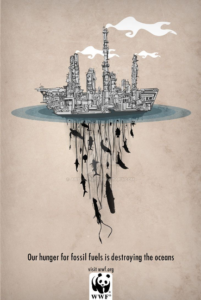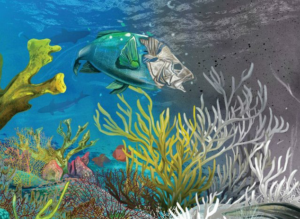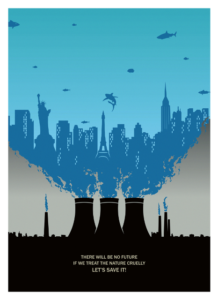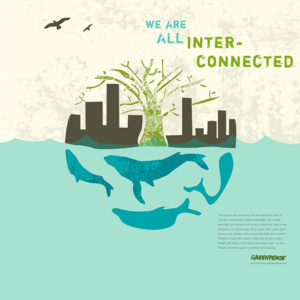
In Field Notes from a Catastrophe by Elizabeth Kolbert, Kolbert discusses and investigates the impact that the rise of carbon dioxide (CO2) has on the ocean. Much of the emission of carbon dioxide, which Kolbert emphasizes, started from the early nineteenth century during the mainstream of industrialization and burning of fossil fuels. Because of our continuation and reliance on this, “nearly half of all the carbon dioxide that humans have emitted since the start of the nineteenth century has been absorbed by the sea.” In the poster above, burning of fossil fuels is heavily emphasized as a dramatic drawback to the ocean and the organisms that inhabit it. While the darkness and the shadowiness represent the fish’s terrible well-being, it is because they are clung to these businesses/industries, the poster demonstrates the correlation of burning of fossil fuels has on the negative impact on the ocean wildlife (which in this case could be death).

Due to the effects of ocean acidification and temperature increases, this has affected many organisms that live in oceans. One organism that Kolbert investigates deep into is coral reefs. Coral reefs are important because they have many functions like providing food and shelter to other organisms. Due to environmental stress from ocean acidification or “When water temperature rises too high, corals expel the algae that nourish them.” Without the zooxanthellae, bleaching (corals turn white) occurs and start to die. This in effects hurts other organisms who rely on coral reefs for survivability. I chose this image because it represents well the contrast between healthy coral and bleached coral. As one can see, in an environment with healthy coral, it is overall more lively which is represented by the present and vibrant colors. However, this is contrasted with the side that is in black and white, symbolizing the emptiness and void of life that persists. This is even further portrayed by the fish in the center whose body is present on both sides. Its lower body has flesh whereas his “head” is mere bones/skeleton, thus exhibiting both characteristics of life and death, portraying similarly to their corresponding sides. Thus, this demonstrates the transition if coral reefs were to bleach, then their surroundings will also transition to die off as well.


Towards the end, while humans have caused indirect damage to oceans by to having emitted a lot of CO2, Kolbert essentially appraises and thanks the seas and oceans for absorbing the CO2 as it has minimized atmospheric concentrations “nearing 500 parts per million” and preventing/reducing certain disasters. She also makes a good point about how ocean acidification has brought to our attention how life on land and life on sea are connected in “unexpected ways”. She points out, “Actions that might appear utterly unrelated – say, driving a car down the New Jersey Turnpike and secreting a shell in the South Pacific – turn out to be connected. To alter the chemistry of the seas is to take a very large risk, and not just with the oceans.” While both from her example don’t seem to be connected, they truly are, as we learned, our actions like simply driving a car indirectly affects oceans and its living organisms. Thus, Kolbert wants us to address these indirect actions. The posters above portray this connection that Kolbert explains. The first poster illustrates the NYC skyline and marine life being emitted by the industrial factories, demonstrating how both of these are shaped by the behavior of these businesses. In the second image, both life on land and life in sea are connected by the ocean like a complete circle. These connections and associations emphasize oceans as necessary for being a part of our daily lives.



